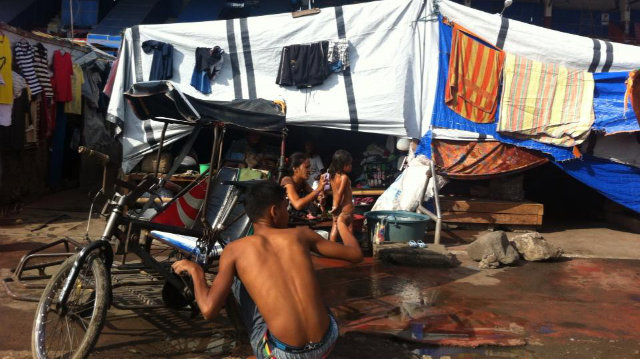SUMMARY
This is AI generated summarization, which may have errors. For context, always refer to the full article.

ZAMBOANGA CITY, Philippines – Isnaira Terek, 47, is a person with disability (PWD). She is a priority recipient in the rehabilitation stage of the Zamboanga Crisis. Terek recalls receiving one pan of bread and an egg to feed her family of five. When she asked for the reasoning behind the small rations of food, she was not given an answer. The distributor told them to just split the little they were given.
In September 2013, a rogue faction of the Moro National Liberation Front (MNLF) clashed with the military, leaving hundreds of Zamboanga City residents displaced.
The fighting may be over but the real humanitarian crisis has only begun.
“The war at our place didn’t traumatize nor cause me to panic, my experience in the Grandstand did,” she said in Chavacano. (READ: Zamboanga: The forgotten crisis)
The everyday challenge of enduring lengthy lines and poor sanitation measures in the main evacuation site, Don Joaquin F. Enriquez Sports Complex (grandstand), worsened matters for internally displaced persons (IDPs) like Terek and her family.
To date, the grandstand houses more than 2,400 families with 13,255 individuals.
Vulnerable
Cash-for-work and food-for-work programs gave the evacuees the temporary capacity to put up makeshift sari-sari stores to earn some income. An evacuee could earn P1000 and 50 kilos of rice for a week’s worth of work under these programs. They used this money to buy goods to sell in their makeshift stores.
When the programs ended, so did their source of income, leaving many of the IDPs vulnerable once again.
Adding to their burdens, the extreme heat is unbearable for IDPs. They have made requests to change their tents to effective shelters against the heat, like nipa huts. However, resources are scarce.
Space is also an issue. In the elevated stands and oval grounds, evacuees live within close proximity to one another. Only a tent separates whole families from other families. Sometimes, several families are made to share a single tent.
“I hope the food provisions do not end, emergencies are not ignored, and the assistance should be equal to all,” said a Sama evacuee. (READ: #AyudaZamboanga: Internally displaced persons need your help)

Sanitation issues
Proper sanitary measures are lacking in the evacuation sites.
“There is a showering area, but the showers are gone now, only the faucets remain. We have to line up to fill our water containers. We also seldom make use of the portalets (portable toilets) because those collecting waste have lesser visits now rendering it unavailable for use,” says Alseyd Jauhari, a Tausug IDP leader.
Jauhari requested authorities to provide maintenance supplies for the portalets to so-called water, sanitation and hygiene (WASH) marshal volunteers. “Before, there were marshals guarding and keeping the portalets clean. Who would want to maintain those now without enough cleaning supplies?”
The City Social Welfare and Development Office (CSWDO) agrees that sanitation is a major problem in evacuation centers. The CSWDO now meets weekly to implement plans to address the the water, sanitation and hygiene issues in temporary shelters.
Relocation?
Terek and her family later relocated to the DonGEMS, an elementary school in Sta. Catalina along with twenty-six other families in November. With no means of living, she satisfies herself with gardening and sweeping the school grounds during the day.
While other evacuees in the grandstand declined to be transferred, Terek agreed mainly to sustain her children’s educational needs. From only two hours of schooling in the grandstand, her children can study for a full day at the DonGEMS site.
Terek and her family are due to be transferred again to a temporary shelter in a nearby lot owned by a local priest. – Rappler.com
Regine Mendoza is a Communication student of the Ateneo de Zamboanga University. She is a researcher for International Organization for Migration and a Rappler intern.
Add a comment
How does this make you feel?
There are no comments yet. Add your comment to start the conversation.